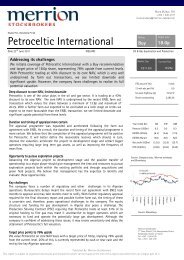Quarterly Bulletin Q3 2013
Quarterly Bulletin Q3 2013
Quarterly Bulletin Q3 2013
Create successful ePaper yourself
Turn your PDF publications into a flip-book with our unique Google optimized e-Paper software.
64<br />
Developments in the International<br />
<strong>Quarterly</strong> <strong>Bulletin</strong> 03 / July 13<br />
and Euro Area Economy<br />
cent during the fourth quarter of 2012. Final<br />
consumption expenditure and net exports of<br />
goods and services contributed 0.6 per cent<br />
and 0.4 per cent, respectively, to the increase<br />
in economic growth. The increase in exports<br />
is associated with the depreciation of the yen<br />
against its main trading partners.<br />
9<br />
8<br />
7<br />
6<br />
Chart 10: BRIC GDP Growth Rates<br />
% Year-on-Year Change<br />
Sentiment data point to a further expansion in<br />
output during the second quarter of <strong>2013</strong>. The<br />
manufacturing PMI increased from 51.1 in April<br />
to 52.3 in June. More forward-looking indicators<br />
point to further increases in economic activity<br />
during the second half of <strong>2013</strong>. PMI new export<br />
orders remain above 50 and increased further<br />
during May. The OECD’s Composite Leading<br />
Indicator (CLI) – which is configured to identify<br />
turning points in economic activity 6 to 9 months<br />
ahead – has remained above 100 since November<br />
and this corresponds to above trend growth.<br />
Since the start of the year, the pace of increase<br />
in the CLI has intensified. The OECD’s Economic<br />
Outlook (May <strong>2013</strong>) shows that projected GDP<br />
growth for <strong>2013</strong> has been revised upwards to 1.6<br />
per cent (see Table 1) with a 1.4 per cent growth<br />
outlook for 2014. Expectations of fiscal expansion,<br />
further easing in financing conditions and an<br />
improvement in export performance in the latter<br />
half of this year underpin these projections.<br />
Since the start of the year deflationary pressures<br />
have intensified despite some easing during<br />
April. Inflation registered -0.7 per cent in April, up<br />
slightly from -0.9 per cent in March but still below<br />
the -0.3 per cent recorded during January. No<br />
changes to monetary policy were made by the<br />
Bank of Japan (BoJ) during May or June. One<br />
of the objectives of the new monetary policy<br />
strategy announced by the BoJ in April is to<br />
double the amount of base money in circulation<br />
within two years. Base money rose by 31.6 per<br />
cent year-on-year during May following a 23.1<br />
per cent year-on-year expansion in April.<br />
BRIC Economies<br />
With the exception of Brazil, the BRIC<br />
economies are showing signs of a loss of growth<br />
momentum. Reflecting this, the IMF and OECD<br />
have revised downwards projected GDP growth<br />
during <strong>2013</strong>. For the most part price pressures<br />
remain elevated. A consequence of this is that<br />
the scope for more accommodative monetary<br />
policy remains limited.<br />
5<br />
4<br />
3<br />
2<br />
1<br />
0<br />
Q2<br />
<strong>Q3</strong><br />
Q4<br />
Q1<br />
Q2<br />
<strong>Q3</strong><br />
Q4<br />
Q1<br />
In China, annualised GDP growth slowed<br />
unexpectedly from 7.9 per cent in the fourth<br />
quarter of 2012 to 7.7 per cent during the<br />
first quarter of <strong>2013</strong>, mainly owing to weaker<br />
investment. By contrast, private consumption<br />
accelerated and was the main driver of growth,<br />
while net trade also made a positive contribution.<br />
Sentiment data relating to the second quarter<br />
point to a further slowdown in economic activity.<br />
The manufacturing PMI, fell from 49.2 in May<br />
to 48.2 in June and this points to a further<br />
deterioration in business conditions for China’s<br />
manufacturing economy. The composite output<br />
PMI including services business activity fell<br />
from 50.8 in May to 49.8 in June. Total social<br />
financing, which is a broad measure of credit, fell<br />
by almost one third to 1.19 trillion yuan during<br />
May. Price pressures remain muted and inflation<br />
dropped from 2.4 per cent in April to 2.1 per<br />
cent in May, while the producer price index was<br />
negative for the fourteenth consecutive month<br />
in April. The most recent projections for GDP<br />
growth in <strong>2013</strong> and 2014 have been revised<br />
downwards by the IMF and the OECD owing to<br />
concerns about the sustainability of growth along<br />
with heightened risks in individual sectors.<br />
In Brazil, GDP increased by 1.8 per cent on an<br />
annualised basis during the first quarter of <strong>2013</strong>,<br />
up from 1.4 per cent recorded during the fourth<br />
quarter of 2012. Inflation continues to rise and<br />
registered 6.5 per cent in mid-May which is at<br />
Q2<br />
2012 <strong>2013</strong> 2012 <strong>2013</strong> 2012 <strong>2013</strong> 2012 <strong>2013</strong><br />
Brazil China India Russia<br />
Source: Thomson Reuters Datastream.<br />
<strong>Q3</strong><br />
Q4<br />
Q1<br />
Q2<br />
<strong>Q3</strong><br />
Q4<br />
Q1




